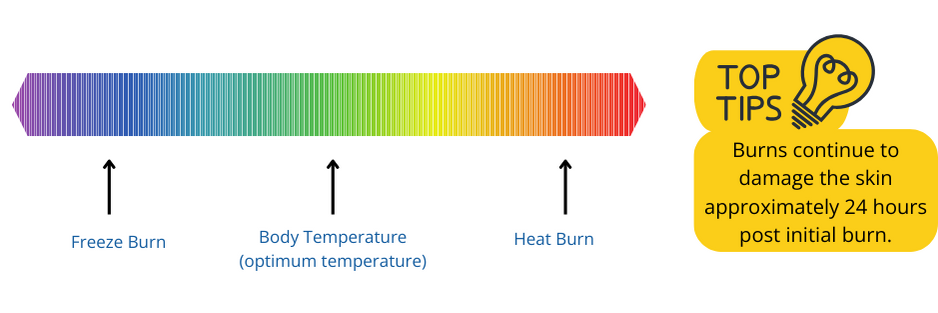
It’s important to remember that every cell has an optimum temperature range. When cells are exposed to temperatures outside of this range, they can become damaged. If the damage is beyond repair, the body will send immune system cells to kill and remove the damaged cells.
The skin retains heat like a cooktop retaining heat after it’s turned off. Therefore, the goal is to minimise the time the skin spends outside its optimum temperature range. Ice is not recommended to soothe a burn, as this can further damage the skin. Room temperature or slightly cooled water is better for cooling the skin. It is closer to our body temperature and can effectively cool the skin when applied for sufficient time.
Furthermore, covering the burn with a clean, non-stick dressing can provide protection and prevent infection. Avoid using cotton balls or fluffy materials that may stick to the wound and cause further discomfort. It’s advisable not to pop blisters. Skin acts as a natural bandage and helps protect the healing tissue underneath. If the blister is larger than a 50-cent coin, it is advised to seek medical attention. Likewise, seek medical attention if the burn is severe, covers a large area, or shows signs of infection such as increased pain, swelling, redness, or oozing.

steps to Protect Skin post a burn
- Remove yourself from danger and immediately run the affected area under cool water for as long as tolerated.
- Assess the affected area. If the burn is present over a joint, face, or large portion of a limb, accessing medical attention is recommended.
- If the burn does not involve vital structures and seems manageable, continue to cool the skin. Keep the affected area under a running tap with cool water at room temperature or spray the area with water every 20 minutes for as long as tolerated.
- Apply a dressing to protect the damaged skin from potential infection and to assist in continual cooling and moisturising.
- Review the burn area the following day to check its progress. Re-dressing using moist dressings or cream to add moisture to the skin,
- Monitor the area for signs of infection, such as increased warmth, redness, pain and swelling. If you suspect an infection is present, contact a medical professional.
